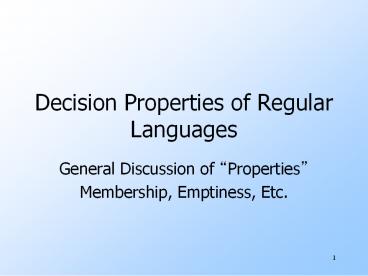Decision Properties of Regular Languages PowerPoint PPT Presentation
Title: Decision Properties of Regular Languages
1
Decision Properties of Regular Languages
- General Discussion of Properties
- Membership, Emptiness, Etc.
2
Properties of Language Classes
- A language class is a set of languages.
- We have one example the regular languages.
- Well see many more in this class.
- Language classes have two important kinds of
properties - Decision properties.
- Closure properties.
3
Representation of Languages
- Representations can be formal or informal.
- Example (formal) represent a language by a RE or
DFA defining it. - Example (informal) a logical or prose statement
about its strings - 0n1n n is a nonnegative integer
- The set of strings consisting of some number of
0s followed by the same number of 1s.
4
Decision Properties
- A decision property for a class of languages is
an algorithm that takes a formal description of a
language (e.g., a DFA) and tells whether or not
some property holds. - Example Is language L empty?
5
Subtle Point Representation Matters
- You might imagine that the language is described
informally, so if my description is the empty
language then yes, otherwise no. - But the representation is a DFA (or a RE that you
will convert to a DFA). - Can you tell if L(A) ? for DFA A?
6
Closure Properties
- A closure property of a language class says that
given languages in the class, an operator (e.g.,
union) produces another language in the same
class. - Example the regular languages are obviously
closed under union, concatenation, and (Kleene)
closure. - Use the RE representation of languages.
7
Why Closure Properties?
- Helps construct representations.
- Helps show (informally described) languages not
to be in the class.
8
Example Use of Closure Property
- We can easily prove L1 0n1n n gt 0 is not a
regular language. - L2 the set of strings with an number of 0s
and 1s isnt either, but that fact is trickier
to prove. - Regular languages are closed under ?.
- If L2 were regular, then L2 ?L(01) L1 would
be, but it isnt.
9
The Membership Question
- Our first decision property is the question is
string w in regular language L? - Assume L is represented by a DFA A.
- Simulate the action of A on the sequence of input
symbols forming w.
10
Example Testing Membership
0 1 0 1 1
11
Example Testing Membership
0 1 0 1 1
12
Example Testing Membership
0 1 0 1 1
13
Example Testing Membership
0 1 0 1 1
14
Example Testing Membership
0 1 0 1 1
15
Example Testing Membership
0 1 0 1 1
16
What if the Regular Language Is not Represented
by a DFA?
- There is a circle of conversions from one form to
another
RE
DFA
e-NFA
NFA
17
The Emptiness Problem An Algorithm
- Given a regular language, does the language
contain any string at all? - Assume representation is DFA.
- Construct the transition graph.
- Compute the set of states reachable from the
start state. - If any final state is reachable, then yes, else
no.

